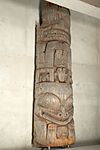naaxwa gyảagang (House Post)
About this object
History of use
This house post once stood against the back wall of a lineage house named Xuuya Naay, or Raven House. As well as supporting one end of the main roof beam, it displayed the inherited privileges belonging to Taajuu ’Laanas: Wind Place Family. The house was situated at the north end of the village, facing the beach, along a small bay on the east side of the island.
Narrative
When this pole was photographed in 1901, at least 50 years after it was carved, Raven House had already been abandoned for several decades. A series of epidemic diseases, including smallpox, had devastated the Haida population, causing people to move away from the village of SGang Gwaay (Ninstints) by the 1880s. The pole was still standing when it was collected in 1957, during a joint salvage expedition by the University of British Columbia and the British Columbia Provincial Museum. The following people assisted with the collecting expedition; Smyly, John; Atkins, Bernard; Reid, Bill; Duncan, Kelly; Jones, Roy; Jones, Clarence; Jones, Frank.
Iconographic meaning
The crests belong to the lineage of the owners of the house, the 'Sand Town People' of the Raven moiety. They may also refer to the Bear Mother myth.
Physical description
Totem, crescent shaped in cross section, carved in shallow and deep relief. From base to top: Bear with human between forelegs, cub between ears, and frogs in ears; human with unknown creature beneath hands. The upper figure has its arms folded with the elbows resting on the squared ears of the figure below. Enclosed within this frame is a small face with a beak. The lower figure, the bear, has curled nostrils, an upturned mouth, raised forearms with five fingers folded over each palm, and a small human face between its paws.
